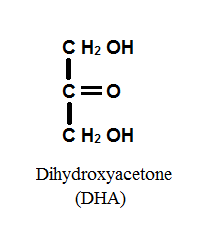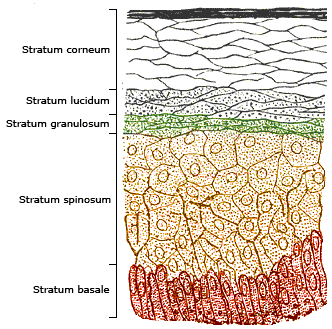The sunless tanner has provided an alternative to sun-kissed skin that does not have an effect on premature aging or an increased risk of skin cancer. Instead of exposure to ultraviolet rays, sunless tanners use a natural ingredient, dihydroxyacetone, that reacts with dead skin cells on the outermost layer of the skin, temporarily staining it a darker brown, dubbed the Maillard Process. Types of sunless tanners range from wipes to creams, and many are becoming readily available for consumers.
Introduction
Having a tan, sun-kissed body has long been a popular aesthetic for both men and women of all ages. Public awareness about the dangerous side effects of exposure to ultraviolet rays, however, has increased in recent years. Signs of premature aging, as well as of increased skin cancer risk, can now be attributed to sunbathing [1]. It nevertheless appears that these deleterious consequences have failed to impact society as profoundly as dermatologists would have hoped. Tanning bed salons, which use artificial UV rays, continue to populate malls and suburban shopping centers, and the media persists in promoting a “just off the beach” tan in both entertainment and fashion.
With this high demand for maintaining a tanned appearance, many cosmetic companies have created sunless tanning solutions that are both convenient and safe, eliminating the need to spend hours “baking” in the sun. These sunless tanners have increased in popularity as countless brands create different formulas and methods of application. In addition, sunless tanners are a healthier option than sunbathing, as they have no ties to increased risks of skin cancer and premature aging.
Although it may appear that sunless tanners hold only a superficial place in the world of engineering, they in fact represent the extent to which simple chemical techniques can be deployed to radically shape the modern landscape of cosmetic products. Their introduction has instilled the tanning process with new ease and accessibility, removing the sun from the equation entirely while allowing millions to rapidly obtain the appearance they desire. Most importantly, sunless tanners actually have profound implications for the advancement of human health, diminishing the dangerous roles of the tanning booth and the sunny lounge chair in the tanning process. For these reasons, their place in the scientific world is far from skin-deep.
What Is a Sunless Tanner?
A sunless tanner creates a chemical reaction on the surface of the skin that gradually darkens the top layer of skin, resembling the appearance of a suntan. Although a sunless tanner will last longer than a bronzer, which is water soluble, it is a temporary coloration that last 4-10 days, depending on the product and sloughing of skin cells [2]. Originally released on the market about 50 years ago, the sunless tanning industry has grown exponentially in recent years. With improvements in composition and application methods, there are now a variety of choices in brands, prices, and types of sunless tanners. Some of the most popular types of applications include daily moisturizers, mousses, aerosol mists, serums and even tanning wipes that deposit the formula all over the body [3]. All these alternative methods leaves the skin darkened, resembling a post-vacation glow.
What’s in It?
The most common active ingredient in these sunless tanners is dihydroxyacetone, or DHA. In the 1950s, Eva Wittgenstein was researching the use of DHA in treating children with metabolic disorders at the Children’s Hospital at the University of Cincinnati in Ohio. She gave the children a concentrated sweet solution that incorporated DHA, and when children spilled some of this solution on their body, it revealed darker patches of skin hours later. After reproducing the effects on her own skin, she discovered a new use of DHA [6].
DHA (C3H6O3), whose structure is pictured in Fig. 1, is a colorless three-carbon sugar. Created and used during glycolysis, this non-toxic simple sugar is naturally occurring in higher plants and animals and is also metabolized more quickly than glucose. In the case of sunless tanners, dihydroxyacetone is usually produced from bacteria, Acetobacter suboxydans, or obtained from sugar cane and sugar beets. DHA is found to be most stable between pH levels of 4 and 6 and will react with a number of ingredients, including nitrogen and oxygen [5].
Although tan accelerators containing tyrozene and tanning pills that use canthaxanthin are available on the market, the FDA has not yet approved these methods, and little information is available on their effects [2]. Dihydroxyacetone, on the other hand, was approved by the FDA in the 1970s and is often listed as the most successful ingredient for a sunless tan. The FDA states, “DHA is listed in the regulations as a color additive for use in imparting color to the human body” [4]. It is, however, restricted to external application and cannot be used on the lips or eyes.
How a Sunless Tanner Works
The human skin is made up of several layers. The epidermis itself, the surface layer, lies above the dermis. The outermost layer of the epidermis, or what is visible to the eye, is the stratum corneum. This is the level where most sunless tanners react with the dead skin cells. Sun tanning, on the other hand, occurs at the deepest layer of the epidermis, known as the stratum basale [5]. The different layers of the epidermis can be seen in the diagram in Fig. 2.
When the sunless tanner is applied to the skin, DHA reacts with the amino acids available in the skin. This reaction between sugar and amino acids is commonly known as the Maillard Process.
Maillard Process
A familiar reaction to food chemists, the Maillard Process involves amino acids reacting to simple sugars in increasing temperatures to produce golden brown compounds [5]. This can be seen often in the caramelization of onions, toasting of bread, and cooking of steak. This process is also responsible for the distinctive golden brown color of beer [6].
Similar to the effect of the Maillard Process applied in cooking, the DHA and amino acid groups of protein in the skin react to form a pigmentation, or melanoidins, on the outermost layer of the epidermis to resemble an artificial tan. Because the body sloughs off dead skin cells at a rapid rate, the effects of sunless tanners fade. In order to maintain the tan, most products suggest applying the sunless tanner every few days [2].
In order to address stability issues with DHA, most products are kept at a concentration level of 3 to 5% [2]. Desired darkness can be reached through multiple applications of the product, and results can be seen within a few hours. In order to prolong the color, exfoliation of the outermost layer of dead skin cells will reveal a newer layer of skin and postpone the shedding of colored skin cells.
Decrease in Risk
Though many people have the misconception that tanner skin is less prone to the dangerous effects of ultraviolet rays, studies have shown the DHA have little to no protective properties against ultraviolet rays. However, the use of sunless tanners in conjunction with education on the harmful effects of ultraviolet rays was found to be effective in women in decreasing the likelihood of sunbathing by 33%. On the other hand, those without sunless tanners that received the same information on ultraviolet rays were only 10% less likely to sunbathe [7]. The use of sunless tanners can be beneficial in decreasing the desire to expose skin to harmful rays for extended periods of time, but the use of sunscreen with SPF is still critical to protecting the skin.
Past and Planned Improvements
In a study conducted in 2003 and published in the British Journal of Dermatology, scientists discovered that several factors affect the outcome of DHA use in sunless tanners. Hydration, pH levels, and availability of amino acids were critical to the different performances of DHA sunless tanners. Altering the different factors influenced pigmentation levels and longevity of the color in test subjects. These results are the cornerstone for improvements in sunless tanners [5].
When sunless tanning products originally hit the market, most were easily identified by the orange hue they produced on the skin. Improvements in the composition of sunless tanner formulas as well as purer forms of DHA have created a more natural appearance. Some common issues that still exist for sunless tanners are even applications, as well as the time it takes for a visible difference in skin color [2]. Because the distribution of amino acids on the epidermis is irregular, it is often difficult to get an even coverage, leaving behind splotchy areas or different shades. Also, when the development process takes too long, the concentration of DHA decreases through contact with clothes and sweating. A patent for a new formula of sunless tanning claims that it provides a more uniform and quicker customized color through the addition of amphoglycinate together with DHA to enhance the effect of active ingredients [8].
The Future of a Growing Industry
Sunless tanners are now readily available in drug stores and high-end cosmetic boutiques alike. With increased sales, the sunless tanner industry has grown to a worth of over $200 million per year, and it continues to grow today. Covering an age range of 18 to 80, geared toward both men and women, this industry has mass-market appeal and will likely persist for years to come [3].
With current trends of bronzed skin continuing, the risk of exposure to ultraviolet rays remains. However, sunless tanning products provide a more convenient and safer alternative to the endless hours in the sun (see Fig. 3) and all the harmful effects that come with it. With improvements in DHA-infused sunless tanning technology, a natural glow has never been easier. And although sunless tanners do not take the place of sunscreen, they can decrease the need for sunbathing. This growing industry continues to expand as the formulas and methods applications are refined. Baking in the sun is no longer the only way to tan the skin: a beautiful and natural glow can now be achieved without the use of ultraviolet rays.






